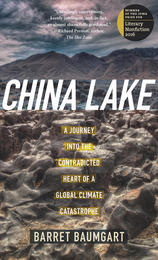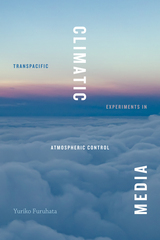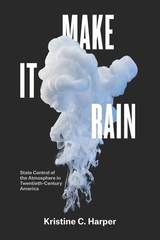3 books about Weather control

China Lake
A Journey into the Contradicted Heart of a Global Climate Catastrophe
Barret Baumgart
University of Iowa Press, 2017
Barret Baumgart’s literary debut presents a haunting and deeply personal portrait of civilization poised at the precipice, a picture of humanity caught between its deepest past and darkest future. In the fall of 2013, during the height of California’s historic drought, Baumgart toured the remote military base, NAWS China Lake, near Death Valley, California. His mother, the survivor of a recent stroke, decided to come along for the ride. She hoped the alleged healing power of the base’s ancient Native American hot springs might cure her crippling headaches. Baumgart sought to debunk claims that the military was spraying the atmosphere with toxic chemicals to control the weather. What follows is a discovery that threatens to sever not only the bonds between mother and son but between planet Earth and life itself.
Stalking the fringes of Internet conspiracy, speculative science, and contemporary archaeology, Baumgart weaves memoir, military history, and investigative journalism in a dizzying journey that carries him from the cornfields of Iowa to drought-riddled California, from the Vietnam jungle to the caves of prehistoric Europe and eventually the walls of the US Capitol, the sparkling white hallways of the Pentagon, and straight into the contradicted heart of a worldwide climate emergency.
Stalking the fringes of Internet conspiracy, speculative science, and contemporary archaeology, Baumgart weaves memoir, military history, and investigative journalism in a dizzying journey that carries him from the cornfields of Iowa to drought-riddled California, from the Vietnam jungle to the caves of prehistoric Europe and eventually the walls of the US Capitol, the sparkling white hallways of the Pentagon, and straight into the contradicted heart of a worldwide climate emergency.
[more]

Climatic Media
Transpacific Experiments in Atmospheric Control
Yuriko Furuhata
Duke University Press, 2022
In Climatic Media, Yuriko Furuhata traces climate engineering from the early twentieth century to the present, emphasizing the legacies of Japan’s empire building and its Cold War alliance with the United States. Furuhata boldly expands the scope of media studies to consider technologies that chemically “condition” Earth’s atmosphere and socially “condition” the conduct of people, focusing on the attempts to monitor and modify indoor and outdoor atmospheres by Japanese scientists, technicians, architects, and artists in conjunction with their American counterparts. She charts the geopolitical contexts of what she calls climatic media by examining a range of technologies such as cloud seeding and artificial snowflakes, digital computing used for weather forecasting and weather control, cybernetics for urban planning and policing, Nakaya Fujiko’s fog sculpture, and the architectural experiments of Tange Lab and the Metabolists, who sought to design climate-controlled capsule housing and domed cities. Furuhata’s transpacific analysis offers a novel take on the elemental conditions of media and climate change.
[more]

Make It Rain
State Control of the Atmosphere in Twentieth-Century America
Kristine C. Harper
University of Chicago Press, 2017
Weather control. Juxtaposing those two words is enough to raise eyebrows in a world where even the best weather models still fail to nail every forecast, and when the effects of climate change on sea level height, seasonal averages of weather phenomena, and biological behavior are being watched with interest by all, regardless of political or scientific persuasion. But between the late nineteenth century—when the United States first funded an attempt to “shock” rain out of clouds—and the late 1940s, rainmaking (as it had been known) became weather control. And then things got out of control.
In Make It Rain, Kristine C. Harper tells the long and somewhat ludicrous history of state-funded attempts to manage, manipulate, and deploy the weather in America. Harper shows that governments from the federal to the local became helplessly captivated by the idea that weather control could promote agriculture, health, industrial output, and economic growth at home, or even be used as a military weapon and diplomatic tool abroad. Clear fog for landing aircraft? There’s a project for that. Gentle rain for strawberries? Let’s do it! Enhanced snowpacks for hydroelectric utilities? Check. The heyday of these weather control programs came during the Cold War, as the atmosphere came to be seen as something to be defended, weaponized, and manipulated. Yet Harper demonstrates that today there are clear implications for our attempts to solve the problems of climate change.
In Make It Rain, Kristine C. Harper tells the long and somewhat ludicrous history of state-funded attempts to manage, manipulate, and deploy the weather in America. Harper shows that governments from the federal to the local became helplessly captivated by the idea that weather control could promote agriculture, health, industrial output, and economic growth at home, or even be used as a military weapon and diplomatic tool abroad. Clear fog for landing aircraft? There’s a project for that. Gentle rain for strawberries? Let’s do it! Enhanced snowpacks for hydroelectric utilities? Check. The heyday of these weather control programs came during the Cold War, as the atmosphere came to be seen as something to be defended, weaponized, and manipulated. Yet Harper demonstrates that today there are clear implications for our attempts to solve the problems of climate change.
[more]
READERS
Browse our collection.
PUBLISHERS
See BiblioVault's publisher services.
STUDENT SERVICES
Files for college accessibility offices.
UChicago Accessibility Resources
home | accessibility | search | about | contact us
BiblioVault ® 2001 - 2024
The University of Chicago Press









